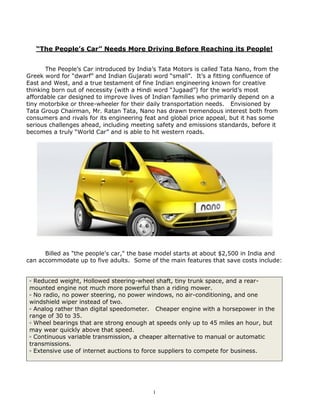
Developing World Needs Tata Nano More
- 1. “The People’s Car” Needs More Driving Before Reaching its People! The People’s Car introduced by India’s Tata Motors is called Tata Nano, from the Greek word for “dwarf” and Indian Gujarati word “small”. It’s a fitting confluence of East and West, and a true testament of fine Indian engineering known for creative thinking born out of necessity (with a Hindi word “Jugaad”) for the world’s most affordable car designed to improve lives of Indian families who primarily depend on a tiny motorbike or three-wheeler for their daily transportation needs. Envisioned by Tata Group Chairman, Mr. Ratan Tata, Nano has drawn tremendous interest both from consumers and rivals for its engineering feat and global price appeal, but it has some serious challenges ahead, including meeting safety and emissions standards, before it becomes a truly “World Car” and is able to hit western roads. Billed as "the people's car," the base model starts at about $2,500 in India and can accommodate up to five adults. Some of the main features that save costs include: ▫ Reduced weight, Hollowed steering-wheel shaft, tiny trunk space, and a rear- mounted engine not much more powerful than a riding mower. ▫ No radio, no power steering, no power windows, no air-conditioning, and one windshield wiper instead of two. ▫ Analog rather than digital speedometer. Cheaper engine with a horsepower in the range of 30 to 35. ▫ Wheel bearings that are strong enough at speeds only up to 45 miles an hour, but may wear quickly above that speed. ▫ Continuous variable transmission, a cheaper alternative to manual or automatic transmissions. ▫ Extensive use of internet auctions to force suppliers to compete for business. 1
- 2. The main hurdles in Nano’s journey include: ▫ Probably fail emission and safety standards on any western road, and, perhaps, in India too in a few years, when the country imposes tougher environmental standards. ▫ New safety rules mandating air bags, antilock brakes and full-body crash tests are also coming to India making it unlikely the car would be able to keep its low price tag for too long. ▫ Unlike cars in the U.S., Indian vehicles do not have to go in for regular inspections. It’s possible that a car so cheap lacks complex technology to maintain its initial level of emissions. ▫ Increase in commodity prices will substantially raise component prices of Nano. Conclusion: Given that the Nano’s sole premise is affordability and cost consciousness, it’s imperative to maintain strict quality standards and compliance as the Tata Group expands its global reach. Even though it’s possible for this “jelly bean” cute car to make it to U.S. shores, why not focus on the developing world, and be a guardian and vehicle of their safety? For the saturated developed world, its relationship with Fiat in Europe and Ford in the US can jointly develop and distribute cheaper car options to make it a cleaner, safer world for all. 2
